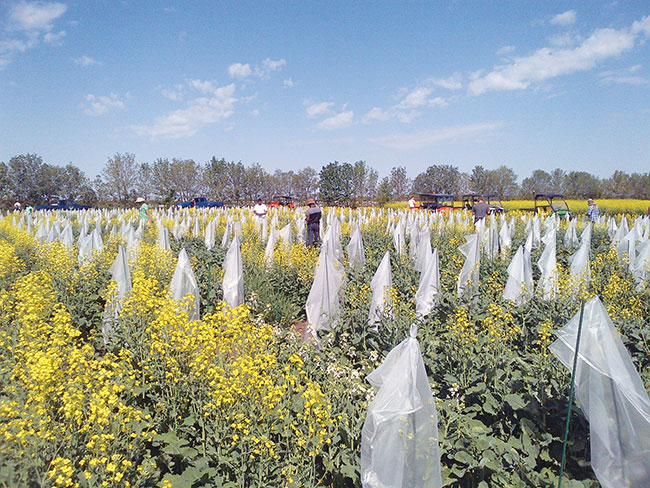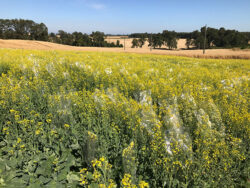
Features
Canola
Weeding out secondary dormancy potential from volunteer canola
Researchers identify genes and develop markers for secondary dormancy in canola.
December 20, 2023 By Donna Fleury
 Seed production experiments conducted in Saskatoon, Sask., field nursery.
PhotoS courtesy of AAFC.
Seed production experiments conducted in Saskatoon, Sask., field nursery.
PhotoS courtesy of AAFC. Volunteer canola, consistently ranked as one of the top weeds on the Canadian Prairies, is linked to secondary dormancy in the seed. Secondary dormancy is influenced by a combination of genetic, environmental, and agronomic factors. Concerns with multiple herbicide resistance, oil profile contamination, and clubroot perpetuation are issues arising from the seed remaining dormant in the seedbank and then germinating and emerging in later years. Researchers are working to better understand genetic factors related to secondary dormancy and develop tools to assist breeding efforts.
“In this most recent project, we are building on earlier work that showed that genetics was a key factor in secondary dormancy potential,” says Sally Vail, research scientist with Agriculture and Agri-Food Canada in Saskatoon, Sask. “Rob Gulden, a researcher with the University of Manitoba, and co-lead on this project, completed work several years ago that identified a wide range of secondary dormancy potential in the canola varieties grown in Western Canada at the time. For some varieties, the potential was quite high. More recent research showed that the genetic component or variety had a very strong influence on the amount of secondary dormancy, which highlighted that this might be a trait that could be selected against.”
In a more recent project, researchers looked at a diverse set of spring Brassica napus lines and genotypes to assess the secondary dormancy potential. A set of about 50 diverse lines were assessed over four different environments. The experiments were conducted in field nurseries for seed production because secondary dormancy cannot be assessed in greenhouse-produced seed. To ensure contrasting environments, especially during seed filling, researchers used field nurseries located locally in Saskatoon and also at a winter nursery in Temuco, Chile. The results showed that although the seed production environment for canola seed played a role in secondary dormancy, genetics played a much bigger role. This documented high heritability of secondary dormancy further supports the feasibility of reducing secondary dormancy in canola cultivars through trait development and selection.
“Based on these results, we were able to take the next step of screening and segregating genetic mapping populations for secondary dormancy,” explains Vail. “We have access to a great genetic and genomic resource, the AAFC spring B. napus Nested Association Mapping (NAM) population developed through a project led by Isobel Parkin. This mapping population design is really suitable for studying complex traits like secondary dormancy and other physiological traits. We are using targeted families within the population that will be most informative once phenotyped for secondary dormancy. Genomic experts Isobel Parkin and Steve Robinson are advisors to the project, providing insights into these traits, which are quite tricky. Using this population also allows us to start to understand different types of associations between secondary dormancy and other traits such as seed germination, vigour and quality. Although in the initial study, we didn’t see a relationship between secondary dormancy and seed vigour, and that secondary dormancy did not reduce vigour.”
University of Manitoba PhD candidate Caroline Brown is leading the genome-wide association study for secondary dormancy to find the correlations between phenotype and genotype. Vail notes that the screening protocol for secondary dormancy potential within lines is quite onerous and requires induction in a dark room. Scaling up the protocol has been more challenging and taking more time than initially anticipated, as the secondary dormancy traits are proving to be very tricky. Through phenotyping, researchers are mapping Quantitative trait loci (QTL) and identifying potential traits and markers for secondary dormancy.

Seed production experiments conducted at a winter field nursery in Temuco, Chile.
“In our progress to date, we are finding that the secondary dormancy trait seems to be controlled by several genes across the loci, which we anticipated,” says Vail. “We are making some headway toward identifying QTLs that we can validate as being critical in terms of contribution to traits, and then look at developing markers for those regions. Being able to scale up phenotyping experiments and find reliable candidates really validates our strategy of trying to find different ways to tackle this problem rather than just developing and screening seedlots. Ultimately, we would like to provide molecular tools or screening tools to commercial breeders in hybrids for selecting against secondary dormancy. Current processes and protocols are too resource intensive in a normal breeding pipeline.”
Vail adds that to reduce the potential of secondary dormancy, it is important to also learn more about the underlying genetics and biology of traits. Caroline has developed preliminary Genome Wide Association Maps and is continuing screening efforts to refine the genetics and identify potential QTLs around the traits. She is also looking at other known candidate genes related to secondary dormancy potential and assessing the variation across the collection of lines.
“We are collecting a lot of data about these mapping populations and the relationships between traits. Ensuring that selecting against one trait doesn’t lead to any negative traits or compromise other important agronomic traits for canola is important. Seed components have been examined for possible relationships with secondary dormancy, and two of interest are carbohydrates and protein. The next step is exploring the expression of candidate genes during secondary dormancy induction. Through our results we want to identify QTLs and potential candidate genes underlying those associated QTLs that represent potential secondary dormancy targets that could be eliminated by using gene editing or novel approaches in the future.”